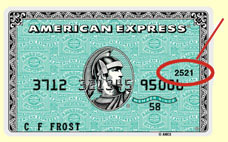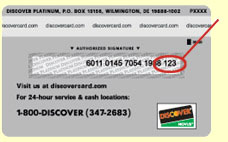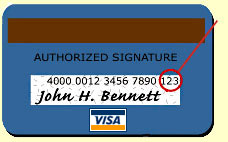Card Security Codes
Introduction
Card Verification Value (CVV) provides an additional level of online fraud protection. The card security codes are 3 or 4 digit codes printed or embossed on Visa, Mastercard, American Express and Discover cards. These codes are also referred to as CVV2, CVC, CSC or CCID. Their purpose is to provide additional protection against fraudulent card use.
Storage and Security Considerations
The card security codes are considered highly sensitive data and should never be stored, even in an encrypted format. Storage of this value will place the merchant in jeopardy with PCI and CISP compliance.
Reference
Where To Find the Code
American Express
A four digit non-embossed number on the face of the card.

Discover
A three digit non-embossed number on the back of the card printed within the signature panel after the account number.

MasterCard
A three digit non-embossed number on the back of the card printed within the signature panel after the account number.

Visa
A three digit non-embossed number on the back of the card printed within the signature panel after the account number.

Response Codes
The following is a list of result codes for the CVV2/CVC2/CID verification system and what each one indicates.
The card security codes are 3 or 4 digit codes printed or embossed on Visa, Mastercard, American Express and Discover cards. These codes are also referred to as CVV2, CVC, CSC or CCID. Their purpose is to provide additional protection against fraudulent card use. Below is a list of possible result codes.
| Code | Meaning |
|---|---|
| M | Match |
| N | No Match |
| P | Not Processed |
| S | Should be on card but not so indicated |
| U | Issuer Not Certified |
| X | No response from association |
| (blank) | No CVV2/CVC data available for transaction. |
Additional Information
For addition information on card security codes please visit the following links:
